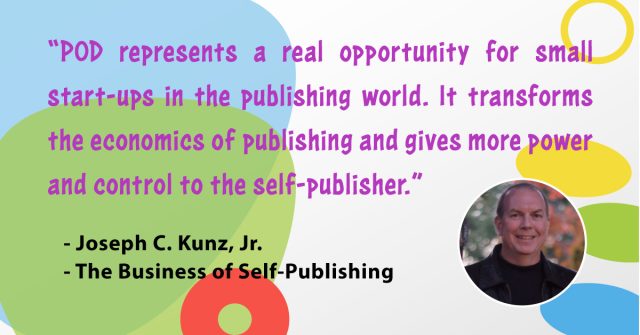Podcast: Play in new window | Download
Subscribe: Apple Podcasts | Spotify | Pandora | RSS | More
Synopsis
Print-on-demand (POD) publishing is a way to have books immediately printed and bound AFTER a customer places an order for the book. This can be a very efficient, fast, and cost-effective way to get books into the hands of customers and readers. The ability to create and sell books, without having to pay for and take delivery of a large inventory of them, has been a major blessing for small and independent publishers.

What You Will Learn
1. You will learn the definition of just-in-time production, and how it relates to POD.
2. You will learn how and why POD has transformed the world of self-publishing.
3. You will learn the reasons why POD is beneficial to large and small publishers.
Introduction
Print-on-demand (POD) publishing is a way to have books immediately printed and bound AFTER a customer places an order for the book. This can be a very efficient, fast, and cost-effective way to get books into the hands of customers and readers. The ability to create and sell books, without having to pay for and take delivery of a large inventory of them, has been a major blessing for small and independent publishers.
Just-in-Time (JIT) Production
Print-on-demand publishing is a form of what is called just-in-time production. This means that when the customer or retailer places an order, the books can be created, within minutes, and sent out – therefore no inventory for the publisher or the author to buy and warehouse.
This process can happen this way because the book printing company has a digital file of the book and its cover in its computerized book-making machine. The book is printed, then a printed cover is glued on, then the book is cut to the appropriate size, and finally, the book is mailed out.
Beneficial to Large Publishers
Print-on-demand publishing has revolutionized the entire publishing industry. Many large publishers use it as a cost-effective way to keep their out-of-print titles in print. Very large publishers can very easily have hundreds of out-of-print titles.
Some of which may be very slow sellers. Why warehouse actual copies of these books when the publisher can simply send a digital file of each book to a POD printer? With the POD method, these out-of-print titles can continue to produce income for the publisher.
Beneficial to Self-Publishers
Print-on-demand publishing is one of the main reasons self-publishing has become so popular and financially feasible for many authors and would-be authors. The upfront costs of POD are much lower than conventional publishing and printing. The cost per copy is higher with POD. But with POD, there is no inventory involved.
Traditional book printers typically require that a self-publisher order hundreds of copies from the printer. With POD, no initial purchase is required. This represents a real opportunity for small start-ups in the publishing world. This transforms the economics of publishing and gives more power and control to the self-publisher.
It allows books to be published with a very small initial investment and ongoing cost. In addition to this, the publisher, or author, can make changes and additions to the book within minutes simply by uploading the new files to the printing company.
What About the Quality Of POD Books?
POD paperback books are printed in a few minutes on computerized copy and binding machines. Traditionally printed paperback books are printed in larger quantities on large-scale printing presses. But today, the print quality is so good that consumers cannot tell the difference between a POD paperback book and a printing press paperback book.

Conclusion
It is very easy to set up an account with a POD printing company and can be started with very little out-of-pocket money. This makes it financially feasible for an individual author, or self-publisher, or small independent publishing company, to enter the publishing business.
And just as important, it eliminates the financial risks of storing an inventory of books; and also makes it very easy to make changes and corrections to the book within minutes. All of these benefits make POD a great option for self-publishers.
Questions For Us To Think About And Discuss
1. Were the benefits of POD part of the reason you believed that self-publishing could be practical and profitable for you?
2. What have been your experiences with POD? In relation to LightningSource and CreateSpace?

